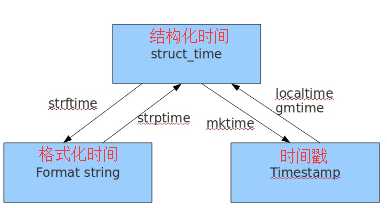标签:空间 utc 奇数 返回 节点 mon .com 偶数 turn
三种格式:
1、时间戳时间(timestamp):浮点数,秒为单位,从1970年1月1日0时距今的时间
1970.1.1 0:0:0 英国伦敦时间(开始时间)
1970.1.1 8:0:0 北京时间(东8区)
2、结构化时间(struct_time): 元组(tm_year(年),tm_mon(月),tm_mday(日),tm_hour(时),tm_min(分),tm_sec(秒),tm_wday(周几,0表示周一),tm_yday(一年中第几天),tm_isdst(是否夏令时))
3、格式化时间(Format String): str数据类型 ‘’2018-9-4‘’

%y 两位数的年份表示(00-99) %Y 四位数的年份表示(000-9999) %m 月份(01-12) %d 月内中的一天(0-31) %H 24小时制小时数(0-23) %I 12小时制小时数(01-12) %M 分钟数(00=59) %S 秒(00-59) %a 本地简化星期名称 %A 本地完整星期名称 %b 本地简化的月份名称 %B 本地完整的月份名称 %c 本地相应的日期表示和时间表示 %j 年内的一天(001-366) %p 本地A.M.或P.M.的等价符 %U 一年中的星期数(00-53)星期天为星期的开始 %w 星期(0-6),星期天为星期的开始 %W 一年中的星期数(00-53)星期一为星期的开始 %x 本地相应的日期表示 %X 本地相应的时间表示 %Z 当前时区的名称 %% %号本身
# 导入时间模块 import time # 时间戳 print(time.time()) # 1536045748.757072 # 格式化时间字符串 print(time.strftime(‘%Y-%m-%d %X‘)) # 2018-09-04 15:26:06 print(time.strftime(‘%Y-%m-%d %H:%M:%S‘)) # 2018-09-04 15:26:06 # 结构化时间 print(time.localtime()) # time.struct_time(tm_year=2018, tm_mon=9, tm_mday=4, tm_hour=15, tm_min=28, tm_sec=0, tm_wday=1, tm_yday=247, tm_isdst=0)
小结:时间戳是计算机能够识别的时间;格式化时间是人能够看懂的时间;结构化时间则是用来操作时间的
几种格式之间的转换:

时间戳转换成结构化时间:
import time # 时间戳-->结构化时间 #time.gmtime(时间戳) #UTC时间,与英国伦敦当地时间一致 #time.localtime(时间戳) #当地时间。例如我们现在在北京执行这个方法:与UTC时间相差8小时,UTC时间+8小时 = 北京时间 print(time.gmtime(1500000000)) # time.struct_time(tm_year=2017, tm_mon=7, tm_mday=14, tm_hour=2, tm_min=40, tm_sec=0, tm_wday=4, tm_yday=195, tm_isdst=0) print(time.localtime(1500000000)) # time.struct_time(tm_year=2017, tm_mon=7, tm_mday=14, tm_hour=10, tm_min=40, tm_sec=0, tm_wday=4, tm_yday=195, tm_isdst=0) # 结构化时间-->时间戳 # time.mktime(结构化时间) time_tuple = time.localtime(1500000000) print(time_tuple) # time.struct_time(tm_year=2017, tm_mon=7, tm_mday=14, tm_hour=10, tm_min=40, tm_sec=0, tm_wday=4, tm_yday=195, tm_isdst=0) print(time.mktime(time_tuple)) # 1500000000.0
格式化时间与结构化时间互相转换:
import time # 结构化时间-->格式化时间 # time.strftime(‘格式定义‘,‘结构化时间‘) 结构化时间参数若不传,则显示当前时间 print(time.strftime(‘%Y-%m-%d %X‘)) # 2018-09-04 16:09:14 print(time.strftime(‘%Y-%m-%d %X‘,time.localtime(1500000000))) # 2017-07-14 10:40:00 # 格式化时间-->结构化时间 # time.strptime(格式化时间字符串,字符串对应的格式) print(time.strptime(‘2018-9-4‘, ‘%Y-%m-%d‘)) # time.struct_time(tm_year=2018, tm_mon=9, tm_mday=4, tm_hour=0, tm_min=0, tm_sec=0, tm_wday=1, tm_yday=247, tm_isdst=-1) print(time.strptime(‘9/4/2018‘,‘%m/%d/%Y‘)) # time.struct_time(tm_year=2018, tm_mon=9, tm_mday=4, tm_hour=0, tm_min=0, tm_sec=0, tm_wday=1, tm_yday=247, tm_isdst=-1)
时间戳转换成格式化时间:
import time # 结构化时间--> %a %b %d %H:%M:%S %Y # time.asctime(结构化时间) 如果不传参数,直接返回当前时间的格式化串 print(time.asctime(time.localtime(1500000000))) # Fri Jul 14 10:40:00 2017 print(time.asctime()) # Tue Sep 4 16:26:10 2018 # 时间戳--> %a %b %d %H:%M:%S %Y # time.ctime(时间戳) 如果不传参数,直接返回当前时间的格式化串 print(time.ctime()) # Tue Sep 4 16:29:00 2018 print(time.ctime(1500000000)) # Fri Jul 14 10:40:00 2017

import time t1 = time.mktime(time.strptime(‘2017-5-1 11:13:44‘,‘%Y-%m-%d %H:%M:%S‘)) t2 = time.mktime(time.strptime(‘2018-9-4 16:33:01‘,‘%Y-%m-%d %H:%M:%S‘)) t3 = t2 - t1 struct_time = time.gmtime(t3) print(‘过去了%d年%d月%d天%d小时%d分钟%d秒‘ % (struct_time.tm_year-1970,struct_time.tm_mon-1, struct_time.tm_mday-1,struct_time.tm_hour, struct_time.tm_min,struct_time.tm_sec)) # 过去了1年4月6天5小时19分钟17秒

# 写函数,计算本月1号的时间戳时间 import time def get_timestamp(): fmt_time = time.strftime(‘%Y-%m-1‘) # 本月1号 struct = time.strptime(fmt_time,‘%Y-%m-%d‘) res = time.mktime(struct) return res print(get_timestamp()) # 1535731200.0
import random # 取随机整数 print(random.randint(1,10)) # 1-10都能取 print(random.randrange(1,10)) # 只能取1-9,取不到10 print(random.randrange(1,100,2)) # 1-99的奇数 print(random.randrange(2,100,2)) # 2-99的偶数 # 取随机小数 print(random.random()) # 0-1之间的浮点数 print(random.uniform(1,10)) # 1-10之间的浮点数 # 从一个列表中随机抽取 lst = [1,2,3,4,5,(‘a‘,‘b‘),‘cc‘,‘dd‘] print(random.choice(lst)) # 以列表里的每个元素为单位取 print(random.choice(range(100))) # 0-99的列表中取一个值 print(random.sample(lst,3)) # 列表中随机取3个元素 # 乱序 lst = [1,2,3,4,5,(‘a‘,‘b‘),‘cc‘,‘dd‘] random.shuffle(lst) print(lst) # 在原有列表的基础上打乱顺序,不产生新列表

import random # 6位数字验证码 def get_code(n=6): code = ‘‘ for i in range(n): num = random.randint(0,9) code += str(num) return code ret1 = get_code() # 默认6位 ret2 = get_code(4) # 改成4位 print(ret1,ret2) # 265326 1548 # 6位验证码,包含数字,大小写字母 def get_code(n=6): code = ‘‘ for i in range(n): num = str(random.randint(0,9)) alpha_upper = chr(random.randint(65,90)) # 大写字母的ascii码是65-90 alpha_lower = chr(random.randint(97,122)) # 小写字母的ascii码是97-122 c = random.choice([num,alpha_upper,alpha_lower]) code += c return code ret1 = get_code() ret2 = get_code(4) print(ret1,ret2) # P9njz1 12Hw # 6位验证码,包含数字,大小写字母(可纯数字) def get_code(n = 6,alph_flag = True): code = ‘‘ for i in range(n): c = str(random.randint(0,9)) if alph_flag: alpha_upper = chr(random.randint(65, 90)) alpha_lower = chr(random.randint(97, 122)) c = random.choice([c,alpha_upper,alpha_lower]) code += c return code ret1 = get_code() # 默认6位数字大小写字母组成 ret2 = get_code(6,False) # 6位纯数字 ret3 = get_code(4,False) # 4位纯数字 print(ret1,ret2,ret3) # wn27w4 808732 1524
os模块是与操作系统交互的一个接口
import os os.mkdir(‘dirname‘) # 相对路径下生成单级目录;相当于shell中mkdir dirname os.makedirs(‘dirname1/dirname2/dirname3‘) # 相对路径下生成多级目录 os.rmdir(‘dirname‘) # 删除单级空目录,若目录不为空则无法删除,报错;相当于shell中rmdir dirname os.removedirs(‘dirname1/dirname2/dirname3‘) # 若目录为空,则删除,并递归到上一级目录,如若也为空,则删除,依此类推 os.listdir(‘D:\python‘) # 列出指定目录下的所有文件和子目录,包括隐藏文件,并以列表方式打印 os.remove() # 删除一个文件 os.rename("oldname","newname") # 重命名文件/目录 os.stat(‘path/filename‘) # 获取文件/目录信息 os.system("bash command") # 运行shell命令,直接显示 os.popen(‘bash command‘).read() # 运行shell命令,获取执行结果 os.getcwd() # 获取当前工作目录,即当前python脚本工作的目录路径 os.chdir("dirname") # 改变当前脚本工作目录;相当于shell下cd # os.path系列 path = ‘D:/python/day23/day23.py‘ os.path.abspath(path) # 返回path规范化的绝对路径 os.path.split(path) # 将path分割成目录和文件名二元组返回 os.path.dirname(path) # 返回path的目录。其实就是os.path.split(path)的第一个元素 os.path.basename(path) # 返回path最后的文件名。如何path以/或\结尾,那么就会返回空值。即os.path.split(path)的第二个元素 os.path.exists(path) # 如果path存在,返回True;如果path不存在,返回False os.path.isabs(path) # 如果path是绝对路径,返回True os.path.isfile(path) # 如果path是一个存在的文件,返回True。否则返回False os.path.isdir(path) # 如果path是一个存在的目录,则返回True。否则返回False os.path.join(‘ D:/python‘,‘day23‘) # 将多个路径组合后返回,第一个绝对路径之前的参数将被忽略 os.path.getatime(path) # 返回path所指向的文件或者目录的最后访问时间 os.path.getmtime(path) # 返回path所指向的文件或者目录的最后修改时间 os.path.getsize(path) # 返回path的大小

stat 结构: st_mode: inode 保护模式 st_ino: inode 节点号。 st_dev: inode 驻留的设备。 st_nlink: inode 的链接数。 st_uid: 所有者的用户ID。 st_gid: 所有者的组ID。 st_size: 普通文件以字节为单位的大小;包含等待某些特殊文件的数据。 st_atime: 上次访问的时间。 st_mtime: 最后一次修改的时间。 st_ctime: 由操作系统报告的"ctime"。在某些系统上(如Unix)是最新的元数据更改的时间,在其它系统上(如Windows)是创建时间(详细信息参见平台的文档)。

os.sep 输出操作系统特定的路径分隔符,win下为"\\",Linux下为"/" os.linesep 输出当前平台使用的行终止符,win下为"\r\n",Linux下为"\n" os.pathsep 输出用于分割文件路径的字符串 win下为;,Linux下为: os.name 输出字符串指示当前使用平台。win->‘nt‘; Linux->‘posix‘
sys模块是与Python解释器交互的一个接口
import sys sys.argv # 命令行参数List,第一个元素是程序本身路径 sys.exit(n) # 退出程序,正常退出时exit(0),错误退出sys.exit(1) sys.version # 获取Python解释程序的版本信息 sys.platform # 返回操作系统平台名称 sys.modules # 查看当前内存空间中所有的模块,和这个模块的内存空间 sys.path # 返回模块的搜索路径,初始化时使用PYTHONPATH环境变量的值
# 一个模块能否被导入,就看这个模块所在的目录在不在sys.path路径中 # 内置模块和第三方扩展模块都不需要我们处理sys.path就可以直接使用 # 自定义的模块的导入工作需要自己手动的修改sys.path

import sys try: sys.exit(1) except SystemExit as e: print(e)
标签:空间 utc 奇数 返回 节点 mon .com 偶数 turn
原文地址:https://www.cnblogs.com/yzh2857/p/9586116.html